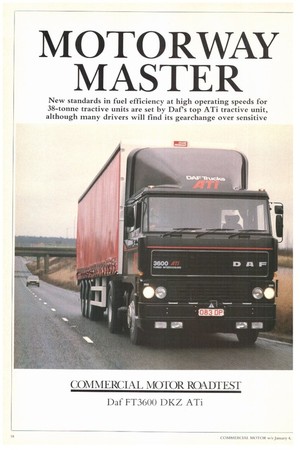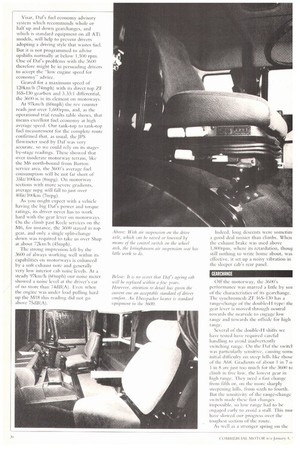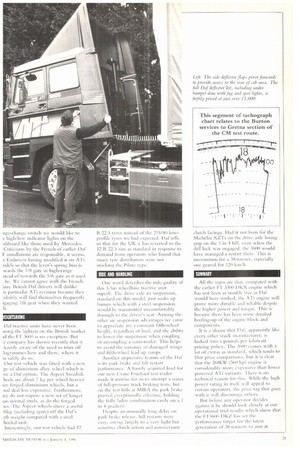MOTORWAY MASTER
Page 18

Page 19

Page 20

Page 21

If you've noticed an error in this article please click here to report it so we can fix it.
New standards in fuel efficiency at high operating speeds for 38-tonne tractive units are set by Dal's top ATi tractive unit, although many drivers will find its gearchange over sensitive
DAF'S new top-of-the-range tractive unit, the FT3600 1)KZ, has become the pacesetter at Mules GCW. No other vehicle we have red to date at that weight over our [85 km Scottish route has been able to itch the remarkable all-round rformance put up recently by the Dst powerful model in the ATi range, aid] was launched just before last ar's Frankfurt show (CM, August 24). Our recorded 40.01it/100km
.(16mpg) overall average fuel nsumption puts the 3600 up in the top helon in its class But more impressive an this first-rate fuel economy is the hide's ability to achieve these figures very high average speeds, indeed, in c case of this operational trial, at cord-breaking average speed.
No doubt, more powerful modem 38nners like the Mercedes 1644, Bice° arboStar or Scania 12142 (tested before c uplift in dual carriageway speed nit, CM, March 31, 1984) could better e 3600's journey times. And, as ;ania's P92 has already demonstrated ost emphatically (CM, September 28, 85), substantially better fuel economy an 401it/100km (impg) is achievable ,rer the Scottish route by less powerful Id slower vehicles. • However, like the MAN 19.361 (CM, ovember 3, 1984) which is surely this af s most directly comparable rival in urope, the FT 3600 1)KZ strikes a very 'pealing balance between high power id fuel economy. It is a balance which early can give a long-distance national 7 international haulier an attractively
high earning potential.
Dal's declared primary objective in the development of the Ali (Advanced lurho intercooled) engines and drivelines was to make its trucks "more efficient transport tools, not simply to join the set mingly relentless race for more power.
PERFORMANCE Yes, the maximum power output of Oars 11.6-litre, in-line, six-cylinder engine has been increased from 246kW (330hp) DIN in the 3300 to 268k W (360hp) 1)LN in the 36110, even though the maximum governed speed has come down by 201/rpm to 2i100 rpm. But this power increase is probably the least significant result or Dais All reengineering. Much more important for the operator is that through careful attention to the breathing, injection and combustion, its torque curve has been made much less peaky (though maxinnini torque has been boosted) compared with earlier 11.6-litre engines. And part-load fuel consumption has also improved over a wide speed range.
A driver used to non-ATi 2800 or 3300 Dalmodels will find the 3600 much more willing to pull at low engine speed. At 1000rpin the DKZ engine is developing a useful 1,356Nrn (1,0001b ft) of torque, rising to a peak of 1,420 Nit] at 1,250 rpm which scarcely falls off at all up to 1,600 rpm. In practice this means that even when the lowest (numerical, highest speed) differential ratio of 3.33:1 is fitted in Daf's own new single-reduction axle (as it was on our test vehicle) at 38 tonnes GCW the 3600's engine can he kept working in the range 1,000 to I ,500rpm and a good over-the-road pace maintained.
When the man from HA. Trucks ((B) recommended whole gear upshifts at 1,500rpm and a splitter upshifts on level ground at as low an engine speed as 1,300rpm, we were sceptical: Similar recommendations front other manufacturers have turned out to be impractical unless we were prepared to accept a snail's pace on the test — we were not.
With the 3600 it is possible to keep the engine working in its most fuel efficient fuel range and still accelerate quite briskly, up motorway slip roads, for example. Despite this, most drivers' natural inclinaticm will be to use the whole green sector of the rev-counter which extends from 1,100 to 1,800 rpm.
Visar, DaFs fuel economy advisory system which recommends whole or half up and down gearchanges, and which is standard equipment on all ATi models, will help to prevent drivers adopting a driving style that wastes fuel. But it is not programmed to advise upshifts normally at below 1,500 rpm. One of Dal's problems with the 3600 therefore might be in persuading drivers to accept the "low engine speed for economy" advice.
Geared for a maximum speed of 120km/h (74mph) with its direct top ZF 16S-130 gearbox and 3.33:1 differential, the 3600 is in its clement on motoways.
At 97km/h (60mph) the rev counter reads just over 1,600rpm, and, as the operational trial results table shows, that means excellent fuel economy at high average speed. Our tank-top to tank-top fuel measurement for the complete route confirmed that, as usual, the JPS flowmeter used by Daf was very accurate, so we could rely on its stageby-stage readings. These showed that over moderate motorway terrain, like the M6 north-hound from Burton service area, the 3600's average fuel consumption will be not far short of 351it/100km (8mpg). On motorway sections with more severe gradients, average mpg will fall to just over 401it/100kin (7mpg).
As you might expect with a vehicle having the big Dal's power and torque ratings, its driver never has to work hard with the gear lever on motorways. On the climb past Keck services on the M6, for instance, the 3600 stayed in top gear, and only a single split-change down was required to take us over Shap at about 72km/h (45mph).
The strong impression left by the 36(X) of always working well within its capabilities on motorways is enhanced by a soft exhaust note and generally very low interior cab noise levels. At a steady 97km/h (60mph) our noise meter showed a noise level at the driver's ear of no more than 74dB(A). Even when the engine was under load pulling hard up the MI8 this reading did not go above 75d8(A). Indeed, long descents were sometim. a good deal noisier than climbs. When the exhaust brake was used above 1,800rpm, where its retardation, thoug still nothing to write home about, was effective, it set up a noisy vibration in the sleeper cab's rear panel.
CEARCHANCE
Off the motorway, the 3600's performance was marred a little by son or the characteristics of its gearchange. The synchromesh ZF 16S-130 has a range-change of the double-I I type: the gear lever is moved through neutral towards the nearside to engage low range and towards the offside for high range.
Several of the double-H shifts we have tested have required careful handling to avoid inadvertently switching range. On the Daf the switcl was particularly sensitive, causing some initial difficulty on steep hills like those of the A68. Gradients of about I in 7 o I in 8 are just too much for the 3600 to climb in five low, the lowest gear in high range. They need :1 last change from fifth or, on the more sharply steepening hills, from sixth to fourth. But the sensitivity of the range-change switch made thesefist changes impossible, so low range had to be engaged early to avoid :I stall. This mu: have slowed our progress over the toughest section of the route.
As well as a stronger spring on the nge-change switch we would like to c high/low indicator lights on the ishboard like those used by Mercedes. Criticisms by the French of earlier Dal F installations are responsible, it seems, r Einhoven having modified it on Ali odds so that the lever's spring bias is wards the 718 gate in .high-range stead of towards the 5/6 gate as it used be. We cannot agree with the french. any British Daf drivers will dislike is particular .ATi revision because they .obably will find themselves frequently igaging 7th gear when they wanted Ii.
EIGHTSAVING
Dal tractive units have never been nong the lightest on the British market id the FT 3600 is no exception. But .e company has shown recently di at it keenly .iware 01 die need to trim off logrammes here and there, where it in safely do so.
Our test vehicle was fitted with a new .pc of aluminium alloy wheel which is aw a Dal option. The Aspect Swedish .heels arc about 7 kg per wheel heavier ien forged aluminium wheels, but a aod deal less expensive. Furthermore. ley do not require a new set of longer tan normal studs, is do the forged :les. The Aspect wheels shave a useful 15kg (including spare) off the Daf's ,.!rb weight compared with a steel 'heeled unit.
Interestingly, our test vehicle had 12 R 22.5 tyres instead oldie 215/80 lowprofile tyres we had expected. Dal tells us that for the UK it has reverted to the 12 R 22.5 size as standard in response to demand from operators who found that many tyre distributors were not stocking the Pilote type.
RIDE AND HANDLING
One word describes the ride quality of this 3.5m wheelbase tractive unit: superb. The drive axle air suspension, standard on this model, just soaks up bumps which with a steel suspension would be transmitted uncomfortably through to the driver's seat. Among the other or suspension advantages we came to appreciate are a constant fifth-wheel height, regardless of load, and the ability to lower the suspension when coupling or uncoupling a semi-trailer. This helps to avoid the no of wings and fifth-wheel lead up ramps.
Another impressive feature of the Dal is its park brake and hill restart performance. A hastily acquired load for our new Crane Fruehauf test trailer made it unwise for us to attempt a series of full-pressure track braking tests, but on the test hills at MIRA the park brake proved exceptionally effective, holding the tnlly laden combination easily on a 1 in 4 gradient.
Despite an unusually long delay on park brake release, hill restarts were easy. owing largely to a very light but sensitive clutch action and non-ceramic clutch facings. Had it not been for the Michelin XZTs on the drive axle losing grip on the 1 in 4 hill, even when the dill lock was engaged. the 3600 would have managed a restart there. This is uncommon for a 38-tonner, especially one geared for 120 km/h.
SUMMARY
All the signs are that. compared with the earlier FT 3300 11)1 It is a shame that Dal, apparently like every other truck manuficturer, is locked into a pounds per kilowatt pricing policy. The 3600 comes with a Lot of extras as standard, which tends to blur price comparisons, but it is clear that the 268kW (3(11 hp) engine is considerably more expensive than lower powered ATi variants. There is no technical reason for tins. While the high power rating, in itself will appeal to certain operators, the price tag that goes with it will discourage others. But before any operator decides against it he should look closely at our operational trial results which show that the FI-301)) DK/. has set the performance target for the latest generation of 38 winters to aim at.


































